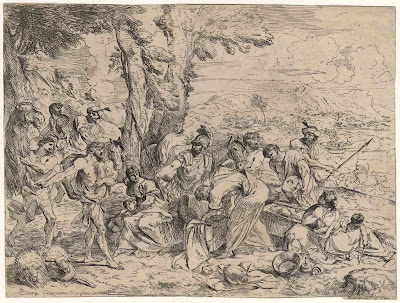Giovanni Benedetto Castiglione (aka Il Grechetto) (1609–64)
“Laban
searching for idols among Jacob's possessions”, c.1635–40, from the 1740
edition by Jacob Frey (1681–1752)
Etching on buff
coloured laid paper trimmed along the image borderline.
Size: (sheet) 24.6
x 32.9 cm
State iv (of
iv) with the addition of the publisher details
Inscribed within
the image borderline at lower left: "Gio Benedetto Castiglione
Genovese"
Lettered below
the image borderline at lower right: “Rome apud I. Frey 1740”
TIB 46 (21).4
(11) (Walter L Strauss & Paolo Bellini [Eds.] 1982, “The Illustrated
Bartsch”, vol. 46, p. 18); TIB Comment.4602.004 S2; Bartsch XXI.11.4 (Adam von
Bartsch “Le Peintre graveur”. Vienna, 1803); Bellini 1982 2.IV (Paolo Bellini “L'opera
incisa di Giovanni Benedetto Castiglione” Exh. cat., Castello Sforzesco,
Civiche Raccolte Achille Bertarelli, Milano. Civica raccolta delle stampe A.
Bertarelli, Milan, 1982)
See the
description of this print at The Metropolitan Museum of Art:
See also the descriptions
of impressions from the same 1740 edition held by University of Arizona Museum
of Art and the British Museum: http://uarizona.pastperfectonline.com/webobject/7AFD8496-D9ED-4269-8655-903834857860;
http://www.britishmuseum.org/research/collection_online/collection_object_details.aspx?objectId=1447091&partId=1&searchText=castiglione+Laban&page=1
Condition: excellent
impression of this rare print. The sheet is in superb condition (i.e. there are
no tears, holes, folds, abrasions stains, or foxing) but the sheet has been
trimmed to the image borderline with the publication details lettered outside
the border retained. There are remnants of mounting verso.
I am selling
this exceptionally rare print by the inventor of the monoprint process for the
total cost of AU$835 (currently US$618.49/EUR563.12/GBP477.87 at the time of
posting this listing) including postage and handling to anywhere in the world.
If you are
interested in purchasing this important early print by one of the most famous of
the old master printmakers, please contact me (oz_jim@printsandprinciples.com)
and I will send you a PayPal invoice to make the payment easy.
This print has been sold
For those
unfamiliar with the story of Laban and Jacob in the book of Genesis (Old
Testament), the following extract from the Art Institute of Chicago may be
helpful:
“After fleeing
Laban’s house in the middle of the night, Jacob and his wives, Rachel and Leah
[Laban’s daughters], are overtaken by Laban, who searches for the household
idols stolen by Rachel in an attempt to protect Jacob from another twenty years
of labor under her father’s rule.” (http://www.artic.edu/aic/collections/artwork/26739)
As a
continuation of the story, Rachel had hidden the idols in her camel’s saddlebag
and tells her father (Laban) that she is unable to dismount from the camel
because “the way of women is upon me” (i.e. Rachel was pretending to be suffering from the discomfort of her menstruation
period) (Genesis 31.35). Wicked! … or as Edwin Astin in “Wicked Bible” (2001) points
out, “So often in these stories cunning and deception are praised more than
honest dealings!” (p. 51).
Leaving aside
the story illustrated in this print, what I love about this image is the ease
with which it is drawn. When I look at the figure with the hairy chest, for
instance, I can picture even the great Picasso admiring Castiglione’s
confidence in making every line count. This doesn’t mean that each stroke is laid
with anatomical precision or that the marks are calligraphically beautiful. Instead, each line captures the spirit of the artist’s vision and expresses meaning
without undue refinements. In short, this is the drawing of a master who works
with an unambiguous flow of knowing what is to be expressed and feeling it in
every stroke.
Like all
artists, however, this print exemplifies the artist’s interests and
compositional tendencies. For example, the Art Institute of Chicago in its description
of this print (mentioned earlier) offers the following insights:
“The image
demonstrates Castiglione’s preference for patriarchal themes and his tendency
to place animals in the foreground of his compositions: two sheep rest in the
left-hand corner.”







No comments:
Post a Comment
Please let me know your thoughts, advice about inaccuracies (including typos) and additional information that you would like to add to any post.